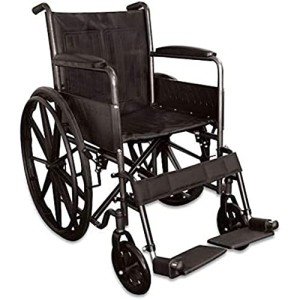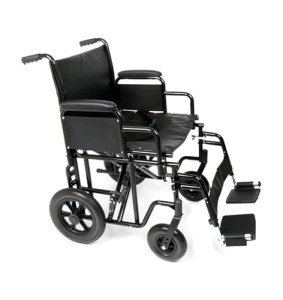You'll Be Unable To Guess Bariatric Mobility Equipment's Tricks
작성일 25-01-30 12:34
페이지 정보
작성자Kimberly 조회 9회 댓글 0건본문
 What to Look For When Selecting Bariatric Mobility Equipment
What to Look For When Selecting Bariatric Mobility EquipmentBariatric mobility equipment assists healthcare facilities offer safe and dignified look after obese clients. To make sure a positive experience for both client and staff, it's essential to know what to look for when choosing this equipment.
Evaluation maker cleansing guidelines and sanitising recommendations. Consider a variety of security features consisting of strengthened frames and locking mechanisms.
Size
Bariatric equipment is built with bigger platforms, increased weight capabilities and greater physical dimensions to help people who weigh more than standard-sized users. This includes people with a Body Mass Index (BMI) of 30 or more. In addition to bigger sizes, bariatric mobility aids use padded seats and head support, enhanced stability and simpler maneuverability to promote comfort and security for clients and click through the next site caregivers.
While the requirement for specialized bariatric mobility equipment is increasing, lots of healthcare centers lack this important equipment. To avoid putting patients at risk, medical specialists should thoroughly assess all options readily available before selecting the best bariatric mobility equipment for their facility.
Properly selected and utilized, specialised handling equipment removes unnecessary struggle that results in injuries throughout transfers, rearranging and moving. By hand raising or moving a client significantly increases the risk of back, shoulder and wrist strain, joint damage and fatigue that can trigger judgement lapses and mishaps. This type of handling likewise exposes personnel to ethical distress, particularly when they are not able to help patients securely and dignifiedly.
To reduce tension on caretakers, bariatric high back wheelchair mobility equipment is normally motorized to decrease push/pull forces and facilitate manoeuvring over distances. To take full advantage of safety, therapists need to have input into all equipment selections and utilize early in the purchasing procedure to make sure suitable sizing for patients as well as to identify distinct requirements that need advanced device personalization or center renovations like expanded passages, entrances and ramps.
When shopping for a bariatric wheelchair, scooter or bed, medical equipment suppliers need to offer details about the device's weight capacity, physical dimensions and building and construction. This details is practical for comparing the features and benefits of each alternative. Taking the time to totally assess this kind of capital equipment can lower the expense of acquisition, wise funding and yearly upkeep. This is particularly important for bariatric mobility equipment that may go through more wear and tear than standard-sized gadgets. This is why choosing the ideal gadget for each client and setting is necessary to reducing direct expenses as well as indirect costs associated with poor results.
Weight Capacity
Unlike standard medical equipment, bariatric mobility aids are created for patients who weigh 350 pounds or more and have a body mass index (BMI) higher than 30. Using undersized or non-bariatric equipment with these patients can cause discomfort, skin breakdown, injuries and falls-- not to point out extra staff effort and time.
Safe dignified client handling is essential for all healthcare employees. However, it can be challenging for staff to handle obese patients without the ideal equipment. This is especially true for mobile patients with elevated requirements that need assistance to move from bed, toilet or chair.
The ideal sized bariatric wheelchair and patient lifts make it possible for people to maintain independence with comfort, self-confidence and dignity. It likewise makes it possible for nurses and other personnel to focus on medical care rather of manual moving maneuvers that can lead to worker injury.
When selecting bariatric mobility aids, it is necessary to seek advice from the product sizing guide and weight capacity rating before purchasing. The sizing guide ought to be prominently shown in the healthcare facility or clinic so that it is simple for clients and families to find.
Dedicated storage area should be available for the safe and easy retrieval of equipment when it is not in use. This will help to avoid overuse or misuse that could cause damage to the equipment and safety risks for patients.
Other bariatric equipment includes slings and slide boards that attach securely to client lifts for moving bigger clients with ease. These devices make use of momentum and low friction to make sure smooth, stable transfers. They are also ideal for repositioning obese patients in beds or chairs, assisting to prevent pressure ulcers.
Examination tables are another important piece of bariatric mobility equipment for helping heavier clients. Bariatric examination tables use greater load capabilities and broader widths than standard models to enable much safer and more comfy positioning of obese patients. Electric variations with powered height modification likewise make it easier for personnel to gain access to and deal with wounds. In addition, the wide bariatric lift bases and longer booms on some equipment permit users to be transferred quickly from wheelchairs and stretchers.
Security
Bariatric client mobility equipment is bigger, much heavier and more robust than standard medical devices. It may for that reason be more difficult to manoeuvre over cross countries or to transport throughout a facility. However, with the ideal training and a comprehensive understanding of safe handling techniques, personnel can mobilise clients successfully without unneeded struggle or danger to them or their care.
The most crucial security features of bariatric mobility aids consist of:
Using the ideal sized equipment for transfers prevents straining staff or putting too much pressure on joints and tissues. It also reduces injuries triggered by mismatched equipment and slings. Bariatric slings connect securely to raise equipment and cradle the body, making them ideal for a wide variety of body shapes. They likewise include padded edges to secure vulnerable skin and strengthened building for durability. Motorised floor raises integrating force sensing units permit caregivers to control transfer movements to ensure they stay within safe working load limits throughout complex manoeuvres. Powered adjustable width transfer surfaces simplify patient manoeuvring, particularly over limits and through doors. Virtual reality simulation systems make it possible for safe handling practice and assessment of bariatric movement capabilities.
All bariatric mobility aids should be checked for damage, wear and tear before and after every use and saved safely when not in use to prevent tripping dangers. They must be routinely cleaned up and sanitised to avoid infection. Personnel must constantly follow manufacturer sizing guidelines and weight limits for lightweight bariatric transport wheelchair mobility aids. Involving therapists early in mobilisation planning assists to figure out correct equipment needs based on specific mobility and practical objectives.
Implementing a detailed patient handling programme that integrates all of the above functions changes care experiences and improves results. This requires leadership top priorities, budgeting, policies, training and culture structure. Carefully assessing the suitability of a gadget and picking an authorised supplier that uses the complete series of choices will assist to attain these goals. Utilizing a developed professional in bespoke mobility options is an excellent way to achieve this. They can provide a totally free assessment, trial rentals and help to discover the best service for your unique requirements.
Flexibility
Picking expert bariatric mobility equipment supports safe, dignified care for people with high body weights. It can minimize staff fatigue and injury, and assist attend to lifestyle problems brought on by immobility. Nevertheless, successful application of these specialised aids depends upon center top priorities, budgets, training and policies.
Bariatric chairs have larger seats and enhanced frames to accommodate a larger weight capacity compared to basic wheelchairs. Some also have reclining backrests and cushioned arms to supply comfort. Numerous have battery-powered choices for self-propulsion, lowering transport and steering efforts. Bariatric beds can deal with people up to 1000 lbs and have broadened surface areas that make space for more body size and weight. Some have power alternatives to change bed height with the touch of a button, making it much easier for nurses and caregivers to perform injury care or administer medications without strain.
Just like all medical equipment, bariatric mobility options must be thoroughly tested before use. Thoroughly assessing the fit, function and ergonomics of equipment assists personnel feel great utilizing it. Training on proper handling principles and techniques-- consisting of sling choice, fitting, upkeep and storage-- is necessary to reduce pressure. Facilities needs to establish a bariatric handling committee to collaborate team efforts and assistance training and optimisation.
Keeping an eye on equipment use and condition needs a clear strategy and procedure, especially for heavy items like bariatric wheelchairs, beds and hoists. Regular audits of equipment, cleansing and maintenance requirements should be undertaken to recognize any issues. Facilities needs to likewise examine policies and equipment choices regularly, particularly when a new version is offered that may improve security, stability or ease of usage.
bariatric aids mobility equipment is generally more costly than basic health care equipment, however the upfront expense can be offset by lowering employee injuries, staffing requirements and expensive issues arising from manual handling. By carefully examining the needs of a center and patient population, as well as choosing a skilled partner to provide the very best equipment for the task, organisations can lower expenses in the long run. For instance, leasing bariatric equipment permits versatility to upgrade designs when new technologies are launched, and avoids the expense of storing equipment that is not in use.

댓글목록
등록된 댓글이 없습니다.